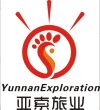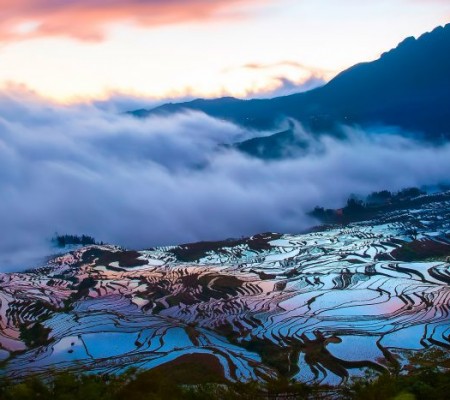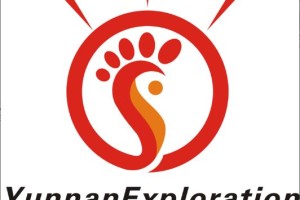
Shi Zhenglan – Inheritor of Traditional Han Costume-making Skill in Chengjiang County, Yuxi
Shi Zhenglan is dedicated to preserving and promoting the unique traditional Han costume culture of Yangzong Town (阳宗镇). The town’s Han women’s attire, characterized by “Manxianggun (满镶滚)” and “Hua Tuojian (花托肩)”, resembles ethnic minority clothing and stands out as a distinctive cultural emblem in Yunnan.
Inheritance and Promotion Activities
Inheritance of Craftsmanship
Shi Zhenglan employs a master-apprentice model to pass down traditional garment-making techniques to younger generations, ensuring the continuity of this cultural heritage.
Cultural Exhibitions
She actively participates in cultural events and exhibitions to showcase Yangzong Town’s traditional Han costumes. For example, during Yuxi City’s Ethnic Costume Festival, the town’s attire captivated audiences with its classical elegance.
Local Cultural Preservation
Beyond technical传承, Shi Zhenglan works to protect and revitalize Yangzong Town’s Han costume traditions, integrating them into the region’s cultural identity.
Through these efforts, Shi Zhenglan has significantly contributed to preserving and revitalizing this unique cultural legacy in modern society.
Distinctive Features of Yangzong Town’s Traditional Attire
Categories of Attire
Yangzong Town’s traditional costumes are primarily divided into two types:
Manxianggun (满镶滚)
- Worn predominantly by elderly women (aged 50+), this style emphasizes simplicity.
- Features black tuojian (托肩) without embroidery, adorned only with multicolored fabric strips and silk braids.
Hua Tuojian (花托肩)
- Historically worn by young women, now reserved for festivals or lantern performances.
- Characterized by a 5-inch-wide, 2-foot-long embroidered tuojian (托肩) at the collar, embellished with auspicious motifs (e.g., camellias, peonies, magpies) or scenes from folklore and daily life.
- Served as traditional wedding attire for Yangzong brides, notable for its vibrant colors and intricate designs.
Design Details
- Upper Garment: Knee-length with elaborate floral borders along the lapel and collar.
- Pants: Paired with “Denglongku (灯笼裤)” (lantern pants), featuring embroidered patterns and silk braids that create a floating effect.
- Shoes: Known as “Ban Jian Shoes (扳尖鞋)”, featuring upturned toes, embroidered floral motifs, and a cloth tab (“Xie Zhuai Ba (鞋拽巴)”) at the heel.
Hairstyle
The attire is completed with “Zhuozi Gaoji (斫子高髻)”, a high chignon popular during the Ming and Qing dynasties. Styling this complex hairstyle requires 40–50 minutes and assistance from others.
Cultural and Artisanal Significance
Craftsmanship Techniques
Shi Zhenglan’s creations demand exceptional skill and cultural insight. For instance, each Hua Tuojian requires precise embroidery of auspicious patterns and meticulous edging with colored silk braids.
Cultural Fusion
Yangzong Town’s attire blends Han and local Yi ethnic elements, reflecting the community’s reverence for tradition and aspirations for prosperity. Through Shi Zhenglan’s dedication, this cultural heritage continues to thrive as a living testament to regional identity.
For Chinese version please go to:
http://www.ynich.cn/view-ml-13111-2725.html

 7 Days GolfingTour
7 Days GolfingTour
 8 Days Group Tour
8 Days Group Tour
 8 Days Yunnan Tour
8 Days Yunnan Tour
 7 Days Shangri La Hiking
7 Days Shangri La Hiking
 11 Days Yunnan Tour
11 Days Yunnan Tour
 6 Days Yuanyang Terraces
6 Days Yuanyang Terraces
 11 Days Yunnan Tour
11 Days Yunnan Tour
 8 Days South Yunnan
8 Days South Yunnan
 7 Days Tea Tour
7 Days Tea Tour
 8 Days Muslim Tour
8 Days Muslim Tour
 12 Days Self-Driving
12 Days Self-Driving
 4 Days Haba Climbing
4 Days Haba Climbing
 Tiger Leaping Gorge
Tiger Leaping Gorge
 Stone Forest
Stone Forest
 Yunnan-Tibet
Yunnan-Tibet
 Hani Rice Terraces
Hani Rice Terraces
 Kunming
Kunming
 Lijiang
Lijiang
 Shangri-la
Shangri-la
 Dali
Dali
 XishuangBanna
XishuangBanna
 Honghe
Honghe
 Kunming
Kunming
 Lijiang
Lijiang
 Shangri-la
Shangri-la
 Yuanyang Rice Terraces
Yuanyang Rice Terraces
 Nujiang
Nujiang
 XishuangBanna
XishuangBanna
 Spring City Golf
Spring City Golf
 Snow Mountain Golf
Snow Mountain Golf
 Stone Mountain Golf
Stone Mountain Golf




